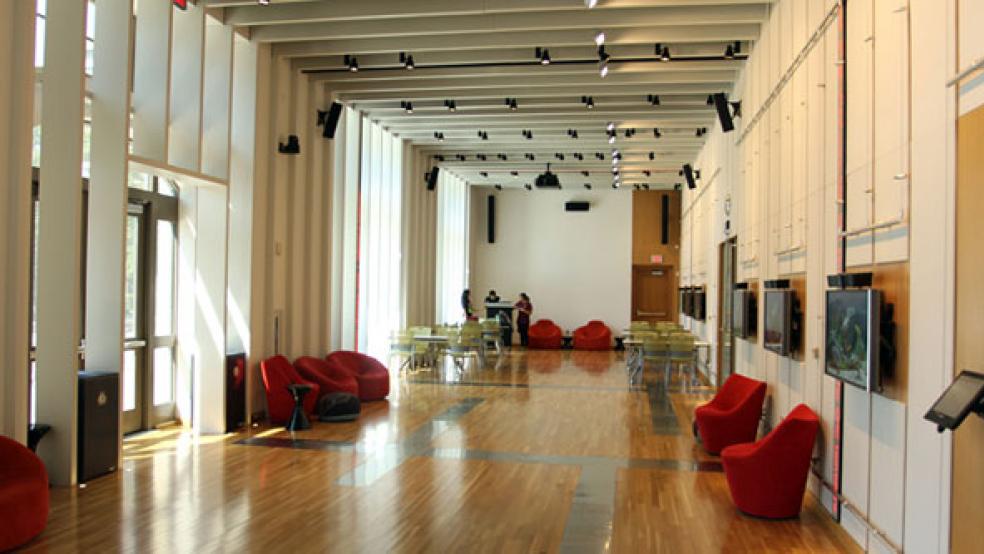Colleges and universities looking to bolster their popularity might take note of what’s happened at Kennesaw State University since 2002. The school was traditionally a commuter university for older students living offsite. But in the late nineties, trustees at the school’s foundation led an effort to boost its enrollment and stature. They decided to lure younger students by offering apartment-style on-campus housing that would provide more privacy and technology than the traditional bunk-bed dorms in which students share a bathroom with 50 others.
RELATED: 10 Public Colleges with Insanely Luxurious Dorms
So in the last 10 years, Kennesaw State has built four new dorm complexes, in addition to renovating an older apartment complex. Today, about 3,500 students live on campus, and every one has a private bedroom. Two-thirds also have their own bathroom, and the other third share with only one other student. And forget the old-style TV lounge—every floor in the freshman dorms has a “plug and play” room with three big-screen TVs with hookups for their electronic devices. That lets today’s multi-taskers watch football on one while gaming on the other two.
It’s no surprise that demand for dorm space at Kennesaw State went through the roof: the school typically has had to cut off its waiting list at 800 students, according to Michael Sanseviro, the school’s dean of student success. Meanwhile, enrollment has doubled and the university has moved from the pedestrian NCAA Division II to the big-time Division I.
“[Students] expect a hotel or resort-type experience.”
Universities and colleges—including state schools of all sizes—are increasingly building on-campus housing with the look and feel of hotels. But the frills come with a price tag, and some experts worry that the trend is raising college costs while driving students further into debt.
Campus housing directors say they’re retooling housing to keep up with the treatment students are getting at home. “When students get to campus, they already have an expectation of having their own room, a bathroom in the room, a whole lot of privacy, and a whole lot of technology and connectivity,” says Ann Bailey, housing director at Mississippi State University. “They want, they expect a hotel, or a condominium, or a resort-type experience.”
Sanseviro, who focused his doctoral work on generational changes, interviewed local high school sophomores and juniors as part of the university’s planning. He was surprised at how many students he talked to had private bathrooms at home. A 2006 study published by the Association of Higher Education Facilities Officers found that “poorly maintained or inadequate residential facilities” was the number one reason that students rejected enrolling at an institution.
Colleges are meeting young people’s expectations because competition for students is heating up. As the last of the millennials graduate and the smaller generation after them, Gen Z or “Generation Net,” enters college, the number of 18-year-olds is shrinking. After rising steadily since 1990, the number of students enrolling in college immediately after high school fell 9 percent from 2008 to 2009, the latest year for which Census figures are available.
‘Hall says the increased housing costs also may be leaking over into tuition increases, which have averaged almost 6 percent a year above inflation at those schools in the last decade.’
“If you look at the demographics, all of higher ed is fighting over fewer students,” says Joshua Hall of the Center for College Affordability and Productivity. Students who can pay full fare, without need-based tuition discounts and substantial school aid, are especially in demand. And they’re the ones most selective in their shopping for a school, he adds.
All of the extras have to be paid for by someone. From 2001 to 2011, average room and board at public four-year colleges rose by about 3 percent a year beyond the rate of inflation, according to data from the College Board. But Hall says the increased housing costs also may be leaking over into tuition increases, which have averaged almost 6 percent a year above inflation at those schools in the last decade: “If you have [high-end dorms], you can get people who are willing to pay more and so you’re able to charge a higher [tuition] price.”
Hall also believes the growth of student loans may be making it easier for students to make expensive choices now that they may be sorry for later. As of the first quarter of this year, the average student loan balance is more than $24,000, and the student loan total now exceeds credit card debt. On-campus room and board at public 4-year colleges costs $8,887 a year on average, according to the College Board, so with a 6.8 percent interest on loans, the price of that first year on campus turns into $12,273 before adjusting for inflation by the end of a 10-year repayment term—a 38 percent increase.
Samantha Barbosa knows that well. In 2009, her senior year at Boston University, she opted for a room on the 25th floor of the school’s brand-new high-rise dorm that offers immaculate views of the city. She had her own room, a walk-in closet, and access to the building’s plush 24-hour study rooms. “It was pretty fantastic,” she says. “You can’t really complain when the dorm where you live is nicer than the last hotel you stayed in.”
‘Students aren’t willing to compromise even when it means financial hardship.’
But her housing cost her $13,000 for that final year, almost $5,000 more than she would have paid for a regular dorm. At the time, “I just sort of had this pessimistic attitude of, ‘well you know I’m taking out thousands of dollars anyway,’” she says. “What’s a few thousand more?” She laughs at that thinking today because “a few thousand more becomes many thousands more with interest. It’s a really big regret that I have now.” Her total debt from her undergraduate years is about $100,000.
Bailey says that on her campus, students aren’t willing to compromise even when it means financial hardship. When students come to the school with concerns about costs, they’re offered less expensive options in traditional dorms. But “they’re unwilling to accept that,” she says. “They want to continue to live in premium style housing that’s going to give them what they’re accustomed to” even if it means going further into debt.
If students are living large at home, it’s no surprise that many of the parents want the best for their children when they’re in college too. “She can study when she needs to study, she can sleep when she needs to sleep, it’s important to her,” one parent told CBS News about her daughter, who was living in a dorm at Purdue University featuring flat screen TVs, free laundry and maid service, private bathrooms, and no roommates.
In addition to charging higher room and board fees, universities are funding their new buildings in a range of ways. Kennesaw State is selling public bonds to raise the money, which they’ll pay off over 30 years with student room and board fees. Other schools are partnering with private companies like American Campus Communities that specialize in building and managing high-end student housing that can cost significantly more than traditional housing. The company builds and manages the facility in exchange for a long-term lease—as much as 85 years, according to a recent New York Times report.
With more public universities looking to build posh dorms to keep up at a time when state money is tight, profits for companies like American Campus Communities are soaring. The company produced shareholder returns from 2010 to 2011 of more than 32 percent.
All of that investment might appear to be coddling the next generation, but universities feel they have little choice. “If schools avoid this type of game [competing to offer the best dorms], they’re doing so at their own peril,” says Hall, since parents and students are already paying so much in tuition. “If you’re in the neighborhood of $30,000 in tuition, people would much rather pay $31,000 and have really nice dormitories.”
Back at Kennesaw State, the dorm-first strategy has been wildly successful. Sanseviro says the average age of students has fallen since 2002, when it was 28—now they attract students just graduating high school. While generating a lot of new revenue through tuition and fees (which have risen between 4 and 6 percent each of the past 3 years), the university has benefited in other ways, he says: “When you become a 24-hour campus… it brings an esprit de corps. We’ve seen a huge shift in culture.”




